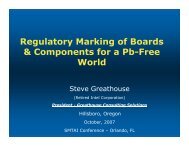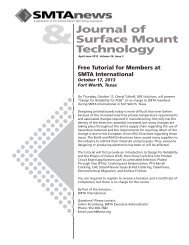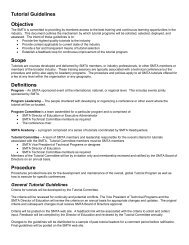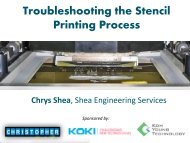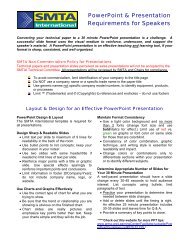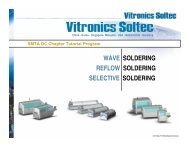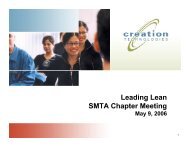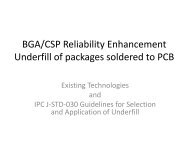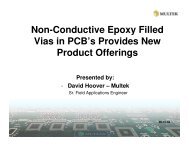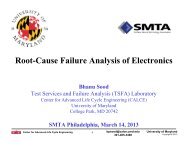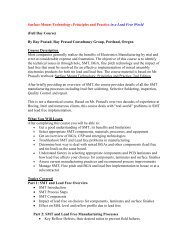A RoHS-Recast (RoHS 2) Primer - Trace Laboratories
A RoHS-Recast (RoHS 2) Primer - Trace Laboratories
A RoHS-Recast (RoHS 2) Primer - Trace Laboratories
You also want an ePaper? Increase the reach of your titles
YUMPU automatically turns print PDFs into web optimized ePapers that Google loves.
John M Radman &<br />
Allison Jandu<br />
<strong>Trace</strong> <strong>Laboratories</strong>, Inc<br />
www.tracelabs.com
Understanding the <strong>RoHS</strong> <strong>Recast</strong> (<strong>RoHS</strong> 2)
Brief History<br />
<strong>RoHS</strong> = Restriction of Hazardous Substances<br />
<strong>RoHS</strong> 1 = Directive 2002/95/EC<br />
<strong>RoHS</strong> 2 = Directive 2011/65/EU 100<br />
Objective = Limit and regulate 6 hazardous substances in<br />
electrical and electronic equipment (EEE)<br />
Cd ≤ 0.01 wt % or 100ppm (batteries, pigments, etc.)<br />
Hg ≤ 0.1 wt % or 1,000ppm (switches, fluorescent<br />
lamps, etc.)<br />
Pb ≤ 0.1 wt % or 1,000ppm (solder, batteries, etc.)<br />
Cr-VI ≤ 0.1 wt % or 1,000ppm (surface coatings)<br />
Polybrominated Biphenyls (PBBs) ≤ 0.1 wt % or<br />
1,000ppm (flame retardants)<br />
Polybrominated Diphenyl Ethers (PBDEs) ≤ 0.1 wt % or<br />
1,000ppm (flame retardants)
Basics of <strong>RoHS</strong> 2<br />
Restrictions<br />
Restrictions do not apply to materials used in the<br />
production process<br />
Restrictions only apply to the finished EEE<br />
Homogeneous Material<br />
A material of uniform composition<br />
A combination of materials that cannot be separated by<br />
mechanical forces<br />
Requirement<br />
Per homogeneous material within a finished EEE<br />
Could be 100s or 1,000s of homogeneous materials in<br />
a finished EEE
Specifics of <strong>RoHS</strong> 2<br />
On 02 Jan 2013, Directive 2002/95/EC was repealed and<br />
replaced by Directive 2011/65/EU 100<br />
<strong>RoHS</strong>-recast objective relates to controlling EEE waste<br />
Simplest means to control waste concerns is to limit the<br />
use of hazardous substances in the manufacturing of EEE<br />
Intention of <strong>RoHS</strong>-recast (as reported by the EU)<br />
Simplify and make Directive more enforceable<br />
Harmonize with other EU legislation<br />
Increase legal clarity (but not necessarily layman<br />
clarity)
Preface<br />
Preface for the remainder of the presentation<br />
I am neither a lawyer nor politician so much of the<br />
“Simplification” and “Clarity” has been lost on me<br />
I will do my best to explain<br />
This is an EU directive and it has no regard for<br />
requirements outside of the EU
<strong>RoHS</strong> vs. <strong>RoHS</strong>-<strong>Recast</strong><br />
Gradual extension of <strong>RoHS</strong> requirements to all EEE by 22<br />
July 2019, including all cables and spare parts (of course<br />
with some exclusions)<br />
Clarification of Definitions (which is helpful)<br />
Mandatory review of Directive by July 2014<br />
Clearer rules for Exemptions including expirations of<br />
existing exemptions<br />
New non-excluded product categories (Annex I)<br />
Category 8, Medical Devices<br />
Many more non-critical/home medical devices<br />
Category 9, Monitoring and Control Instruments<br />
Category 11, Other
<strong>RoHS</strong> vs. <strong>RoHS</strong>-<strong>Recast</strong><br />
Most Significant Difference<br />
Coherence with other EU legislation<br />
New Legislative Framework (NLF)<br />
CE Marking<br />
Declaration of Conformity<br />
Effective as of 03 January 2013<br />
Markings like below should no longer be used
Timeline<br />
(<strong>RoHS</strong> 2 FAQ 6)<br />
Existing EEE outside the scope of <strong>RoHS</strong> 1 but inside<br />
scope of <strong>RoHS</strong> 2 have until 22 July 2019 to comply [Article<br />
2(2)]
Does <strong>RoHS</strong> 2 Apply to My Product<br />
(<strong>RoHS</strong> 2 FAQ 8)
Does <strong>RoHS</strong> 2 Apply to My Product<br />
Is my product EEE<br />
Must be a product that is placed on the market as a<br />
finished EEE<br />
A component sold for further production into an EEE is<br />
not considered a finished EEE
Does <strong>RoHS</strong> 2 Apply to My Product<br />
Annex I – Lists 11 Categories of EEE covered by the<br />
Directive<br />
1. Large household appliances<br />
2. Small household appliances<br />
3. IT and telecommunications equipment<br />
4. Consumer equipment<br />
5. Lighting equipment<br />
6. Electrical and electronic tools<br />
7. Toys, leisure and sports equipment<br />
8. Medical devices<br />
9. Monitoring and control instruments<br />
10.Automatic dispensers<br />
11.Other EEE not covered by any of the categories<br />
above
Scope Exclusion vs. Exemptions<br />
The Scope of the Directive lists the EEE’s to which the<br />
Directive applies<br />
Annex III – Lists Applications “currently” Exempt from the<br />
Restrictions<br />
Distinction<br />
Exemptions can be given to specific substances used<br />
in narrowly-defined applications<br />
Exemptions are not given to an entire category of EEE<br />
product<br />
Exemptions are temporary and eventually expire<br />
Scope Excluded products will likely never have to<br />
comply
Scope Exclusions<br />
Per Article 2(4), Directive does not apply to:<br />
a) Equipment for Military use<br />
b) Equipment sent into Space<br />
c) Equipment installed into other Exempt Equipment<br />
d) Large-scale Stationary Industrial Tools<br />
e) Large-scale Fixed Installations<br />
f) Transportation Equipment<br />
g) Non-Road Mobile Machinery for professional use<br />
h) Implantable Medical Devices<br />
i) Photovoltaic Panels<br />
j) R&D Equipment<br />
Again, Focus is on EEE that enters the waste stream in<br />
high volume
Exemptions<br />
Why are some applications exempt<br />
Exemptions give industry time to ensure that there is a<br />
suitable replacement (i.e.: high-lead solders)<br />
Order of precedence of compliance is based on volume<br />
of product entering the waste stream<br />
EEE containing an application that enters the waste<br />
stream in high volume must comply to <strong>RoHS</strong><br />
EEE containing an application that does not enter the<br />
waste stream in high volume and currently does not have<br />
an alternate compliant application may be exempt from<br />
<strong>RoHS</strong><br />
Reviewed at least every 4 years
Exemptions 1 -13<br />
Per Annex III, Applications currently exempt include:<br />
1) Hg in Compact Fluorescent Lamps (CFL)<br />
2) Hg in other Fluorescent Lamps (FL)<br />
3) Hg in Cold Cathode FL (CCFL) and External Electrode<br />
FL (EEFL)<br />
4) Hg in other specific lamps<br />
5) Pb in specific glass<br />
6) Pb in specific metal alloys<br />
7) Pb in specific solders or EEEs<br />
8) Cd in specific uses<br />
9) Cr-VI or Pb in specific refrigeration applications<br />
11)Pb in compliant pin connectors<br />
12)Pb coating for thermal conduction module C-ring<br />
13)Specific glass
Exemptions 14 - 26<br />
Per Annex III, Applications currently exempt include:<br />
14)Pb solders in microprocessors<br />
15)Pb solders in ICs<br />
16)Pb in specific lamps<br />
17)Pb in high intensity discharge (HID) lamps<br />
18)Pb in fluorescent powder<br />
19)Pb in energy saving lamps (ESL)<br />
20)Pb in glass of LCDs<br />
21)Pb and Cd in specific inks<br />
23)Pb finish on fine pitch components<br />
24)Pb solders for planar array ceramic caps<br />
25)Pb in surface conduction electron emitter displays<br />
(SED)<br />
26)Pb in black light blue lamps
Exemptions 27 - 40<br />
Per Annex III, Applications currently exempt include:<br />
27)Pb in solder of high-powered loudspeakers<br />
29)Pb in crystal glass<br />
30)Cd in solder of high-powered loudspeakers<br />
31)Pb in solder of Hg-free fluorescent lamps<br />
32)Pb in window assemblies of laser tubes<br />
33)Pb in solder in power transformers<br />
34)Pb in potentiometer elements<br />
36)Hg in DC plasma displays<br />
37)Pb in high voltage diodes<br />
38)Cd on Al bonded BeO<br />
39)Cd in specific LEDs<br />
40)Cd in photoresistors
Complications<br />
Additional Exemptions can be added<br />
Annex V provides a procedure for adding, renewing, or<br />
revoking an exemption<br />
Dual or Multiple Use Products<br />
Product with an Inside and Outside the Scope use<br />
If one use is Inside the Scope, the product MUST<br />
comply<br />
If product is non-compliant and sold for excluded use,<br />
seller is responsible for assuring product is only available<br />
for use outside the scope of <strong>RoHS</strong> 2<br />
All components within an Inside the Scope product must<br />
comply
Specific Questions<br />
HMP Solders (>85% Pb alloy)<br />
Exemption 7(a) applies<br />
Expected to expire by 20 September 2015 but not<br />
definite<br />
There are alternatives<br />
Au, Au80Sn20, Au88Ge12, Au96.8Si3.2,<br />
Sn89Sb10.5Cu0.5,etc.<br />
Cannot to get much info from the suppliers<br />
Large-Scale Stationary Industrial Tools (LSSIT) and Large-<br />
Scale Fixed Installations (LSFI)<br />
EEE must be exclusively made for LSSIT or LSFI use<br />
Currently, there is no plan to add these to the Scope<br />
May develop a clearer definition of “Large-Scale” based<br />
on dimensions and weight
OK, So <strong>RoHS</strong> Applies to Me<br />
If your product is an EEE and falls under the Scope for<br />
<strong>RoHS</strong> 2…<br />
It must be marked with the CE marking to display<br />
compliance<br />
You must generate a Declaration of Conformity (DoC)
CE Marking & Declaration of Conformity<br />
“Blue Guide” – Guide to the Implementation of Directives<br />
based on the New Approach and the Global Approach<br />
118 pages<br />
CE Marking<br />
Only marking which symbolizes conformity to ALL<br />
requirements of the product<br />
Declaration of Conformity (DoC)<br />
Document produced by the manufacturer stating that<br />
the product complies with all relevant Directives<br />
All or Nothing<br />
The CE Marking and DoC show that a EEE FULLY<br />
complies with all Directives (<strong>RoHS</strong>, EMI, Low Volt, etc.)<br />
A product cannot have a CE Marking or DoC but only<br />
comply with some Directives
CE Marking<br />
Meaning of CE Marking<br />
EU clearly wants the CE Marking and only the CE Marking<br />
EU stand is that the CE marking is the only marking<br />
that attests conformity of <strong>RoHS</strong> 2<br />
EC/765-2008 – markings, signs, or inscriptions that are<br />
likely to mislead third parties regarding the meaning or<br />
form of the CE marking are prohibited<br />
EU does not want a Pb-Free or other symbol but other<br />
symbols may be acceptable if they do not mislead
Declaration of Conformity<br />
Annex VI<br />
Manufacturer must make a DoC when placing a product<br />
on the market<br />
A single DoC shall reference <strong>RoHS</strong> 2 and any other<br />
relevant Directive<br />
Documentation requirements are listed in Decision<br />
768/2008/EC
What to do Next<br />
3 Options to ensure your product complies<br />
1. Require suppliers to provide DoCs for all parts they<br />
supply and create a DoC for your EEE based off of<br />
supplier DoCs<br />
2. Test your complete EEE to verify compliance<br />
Could be 1,000s of samples<br />
Lot variation<br />
3. Attain supplier DoCs and test:<br />
Materials for which DoCs could not be attained<br />
Materials that may logically contain restricted<br />
substances
Testing<br />
Screening – X-Ray Fluorescence (XRF)<br />
Can non-destructively screen parts of a EEE<br />
Quick and inexpensive, however:<br />
Parts must be of sufficient size<br />
Can give a rough idea of concentration but not<br />
nearly as accurate as techniques inspectors will use<br />
Cannot identify the PBBs, PBDEs, or Cr-VI
Testing<br />
Destructive Testing<br />
Separate EEE into homogeneous materials<br />
This could be very difficult<br />
Individually digest materials in acid<br />
Individually analyze via ICP-OES and GC/MS
Post-Testing<br />
1) Write your DoC<br />
2) Mark your EEE with CE<br />
3) Sell your EEE in the EU without worry<br />
4) Make sure your suppliers do not change anything without<br />
notifying you first
Useful Websites<br />
National Authorities<br />
http://ec.europa.eu/environment/waste/weee/pdf/contacts_ms_rohs.pdf<br />
Blue Guide<br />
http://ec.europa.eu/enterprise/policies/single-market-goods/files/blueguide/guidepublic_en.pdf<br />
<strong>RoHS</strong> 2 Directive<br />
http://eurlex.europa.eu/LexUriServ/LexUriServ.douri=OJ:L:2011:174:0088:0110:e<br />
n:PDF
Questions Comments<br />
Contact info:<br />
John M Radman<br />
Senior Technical Director<br />
jradman@tracelabs.com<br />
410.229.4384<br />
Allison Jandu<br />
Account Manager<br />
ajandu@tracelabs.com<br />
410.229.4367



